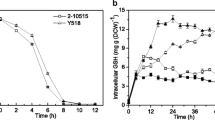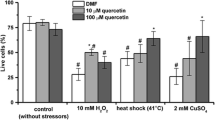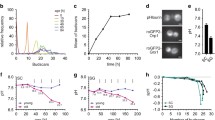Abstract
Glutathione (GSH) is an abundant cellular thiol which has been implicated in numerous cellular processes and in protection against stress caused by xenobiotics, carcinogens and radiation. Our experiments address the requirement for GSH in yeast, and its role in protection against oxidative stress. Mutants which are unable to synthesis GSH due to a gene disruption inGSH 1, encoding the enzyme for the first step in the biosynthesis of GSH, require exogenous GSH for growth under non-stress conditions. Growth can also be restored with reducing agents containing a sulphydryl group, including dithiothreitol, β-mercaptoethanol and cysteine, indicating that GSH is essential only as a reductant during normal cellular processes. In addition, theGSH 1-disruption strain is sensitive to oxidative stress caused by H2O2 and tert-butyl hydroperoxide. The requirement for GSH in protection against oxidative stress is analogous to that in higher eukaryotes, but unlike the situation in bacteria where it is dispensable for growth during both normal and oxidative stress conditions.
Similar content being viewed by others
References
Apontoweil P, Berends W (1975) Isolation and characterization of glutathione-deficient mutants ofEscherichia coli K12. Biochem Biophys Acta 399:10–22
Collinson LP, Dawes IW (1992) Inducibility of the response of yeast cells to peroxide stress. J Gen Microbiol 138:329–335
Douglas KT (1987) Mechanisms of action of glutathione-dependent enzymes. In: Meister A (ed) Advances in enzymology, vol 59, Wiley, New York, pp 103–167
Galiazzo F, Schiesser A, Rotilio G (1987) Glutathione peroxidase in yeast. Presence of the enzyme and induction by oxidative conditions. Biochem Bio Res Comm 147:1200–1205
Greenberg JT, Demple B (1986) Glutathione inEscherichia coli is dispensible for resistance to H2O2 and gamma radiation. J Bacteriol 168:1026–1029
Griffith OW, Meister A (1979) Potent and specific inhibition of glutathione synthesis by buthionine sulfoximine (S-n-butyl homocysteine sulfoximine). J Biol Chem 254:7558–7560
Halliwell B (1991) Reactive oxygen species in living systems: source, biochemistry, and role in human disease. Am J Med 91:14S-38S
Inoue Y, Kobayashi S, Kimura A (1993) Cloning and phenotypic characterization of a gene enhancing resistance against oxidative stress inSaccharomyces cerevisiae. J Ferm Bioeng 75:327–331
Jain A, Martensson J, Einar E, Auld PAM, Meister A (1991) Glutathione deficiency leads to mitochondrial damage in brain. Proc Natl Acad Sci USA 88:1913–1917
Kistler M, Maier K, Eckardt-Schupp F (1990) Genetic and biochemical analysis of glutathione-deficient mutants ofSaccharomyces cerevisiae. Mutagenesis 5:39–44
Kistler M, Summer KH, Eckardt F (1986) Isolation of glutathione-dependent mutants of the yeastSaccharomyces cerevisiae. Mut Res 173:117–120
Lisowsky T (1993) A high copy number of yeast g-glutanylcysteine synthetase suppresses a nuclear mutation affecting mitochondrial translation. Curr Genet 23:408–413
Martensson J, Jain A, Stole E, Frayer W, Auld PAM, Meister A (1991) Inhibition of glutathione synthesis in the newborn rat: A model for endogenously produced oxidative stress. Proc Natl Acad Sci USA 88:9360–9364
Meister A (1988) Glutathione metabolism and its selective modification. J Biol Chem 263:17205–17208
Meister A, Anderson ME (1983) Glutathione. Ann Rev Biochem 52:711–760
Ohtake Y, Satou A, Yabuuchi S (1990) Isolation and characterisation of glutathione-deficient mutants inSaccharomyces cerevisiae. Agric Biol Chem 54:3145–3150
Ohtake Y, Yabuuchi S (1991) Molecular cloning of the g-Glutamylcysteine synthetase gene ofSaccharomyces cerevisiae. Yeast 7:953–961
Penninckx MJ, Elskens MT (1993) Metabolism and functions of glutathione in micro-organisms. Adv Microb Physiol 34:239–301
Schnell N, Krems B, Entian K-D (1992) The PAR1 (YAP1/SNQ3) gene ofSaccharomyces cerevisiae, a c-jun homologue, is involved in oxygen metabolism. Curr Genet 21:269–273
Sies H (1993) Strategies of antioxidant defense. Eur J Biochem 215:213–219
Wu A, Moye-Rowley WS (1994) GSH1, which encodes glutamyl-cysteine synthetase, is a target gene for yAP-1 transcriptional regulation. Mol Cell Biol 14:5832–5839
Author information
Authors and Affiliations
Additional information
Communicated by M. S. Esposito
Rights and permissions
About this article
Cite this article
Grant, C.M., MacIver, F.H. & Dawes, I.W. Glutathione is an essential metabolite required for resistance to oxidative stress in the yeastSaccharomyces cerevisiae . Curr Genet 29, 511–515 (1996). https://doi.org/10.1007/BF02426954
Received:
Issue Date:
DOI: https://doi.org/10.1007/BF02426954




